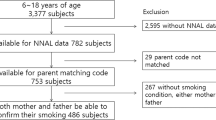Abstract
Factors that might account for the probability of children being exposed to secondhand smoke compared to those who are unexposed and characteristics associated with the urinary cotinine level (UCL) of those who are exposed were investigated. All households in a German region with a child aged 3 years or younger (n = 3,570) were invited to participate in a study that tested the efficacy of an intervention for reducing secondhand smoke exposure. In 1,282 households, at least one parent reported daily smoking. Among these, 915 (71.3 %) participated in the study. For data analyses, we used a two-part model. Characteristics of the households associated with SHSE of the youngest child were analyzed, as well as characteristics associated with UCL among those exposed. Exposure to secondhand smoke was defined using a UCL ≥ 10 ng/ml. Secondhand smoke exposure was detected in 57.1 % of the samples. Nursery attendance was associated with secondhand smoke exposure, in addition to the number of smokers living in the household, extent of home smoking ban and parental education. Among children exposed, nursery attendance, season of urine collection and age of the child were associated with UCL. Consideration of seasonal smoking behavior and a child’s age at the time of intervention may increase attention to the adverse health effects of secondhand smoke exposure.
Similar content being viewed by others
References
Braun, J. M., Froehlich, T. E., Daniels, J. L., Dietrich, K. N., Hornung, R., et al. (2008). Association of environmental toxicants and conduct disorder in U.S. children: NHANES 2001-2004. Environmenatl Health Perspectives, 116, 956–962.
Moritsugu, K. P. (2007). The 2006 Report of the Surgeon General: The health consequences of involuntary exposure to tobacco smoke. American Journal of Preventive Medicine, 32, 542–543.
Yolton, K., Dietrich, K., Auinger, P., Lanphear, B. P., & Hornung, R. (2005). Exposure to environmental tobacco smoke and cognitive abilities among U.S. children and adolescents. Environmental Health Perspectives, 113, 98–103.
He, Q. Q., Wong, T. W., Du, L., Jiang, Z. Q., Yu, T. S., et al. (2011). Environmental tobacco smoke exposure and Chinese schoolchildren’s respiratory health: A prospective cohort study. American Journal of Preventive Medicine, 41, 487–493.
Akhtar, P. C., Haw, S. J., Currie, D. B., Zachary, R., & Currie, C. E. (2009). Smoking restrictions in the home and secondhand smoke exposure among primary schoolchildren before and after introduction of the Scottish smoke-free legislation. Tobacco Control, 18, 409–415.
Öberga, M., Woodward, A., Jaakkola, M. S., Perugad, A., & Prüss-Ustün, A. (2010). Global estimate of the burden of disease from second-hand smoke (2010th ed., p. 71). Switzerland: World Health Organization (WHO).
Hovell, M. F. (2000). Reported measure of environmental tobacco smoke exposure: Trials and tribulations. Tobacco Control, 9, iii22–iii28.
Baxi, R., Sharma, M., Roseby, R., Polnay, A., Priest, N., et al. (2014). Family and carer smoking control programmes for reducing children’s exposure to environmental tobacco smoke. Cochrane Database Systematic Reviews, 3, CD001746.
Boyaci, H., Etiler, N., Duman, C., Basyigit, I., & Pala, A. (2006). Environmental tobacco smoke exposure in school children: Parent report and urine cotinine measures. Pediatrics International, 48, 382–389.
Jaakkola, M. S., & Jaakkola, J. J. (1997). Assessment of exposure to environmental tobacco smoke. European Respiratory Journal, 10, 2384–2397.
Chilmonczyks, B. A., Salmun, L. M., Megathlin, K. N., Neveux, L. M., Palomaki, G. E., et al. (1993). Association between exposure to environmental tobacco smoke and exacerbations of asthma in children. New England Journal of Medicine, 328, 1665–1669.
Jordaan, E. R., Ehrlich, R. I., & Potter, P. (1999). Environmental tobacco smoke exposure in children: Household and community determinants. Archives of Environmental Health, 54, 319–327.
Jurado, D., Munoz, C., Luna, D., & Fernandez-Crehuet, M. (2004). Environmental tobacco smoke exposure in children: Parental perception of smokiness at home and other factors associated with urinary cotinine in preschool children. Journal of Exposure Science and Environmental Epidemiology, 14, 330–336.
Callais, F., Momas, I., Roche, D., Gauvin, S., Reungoat, P., et al. (2003). Questionnaire or objective assessment for studying exposure to tobacco smoke among asthmatic and healthy children: The French VESTA Study. Preventive Medicine, 36, 108–113.
Scherer, G., Kramer, U., Meger-Kossien, I., Riedel, K., Heller, W. D., et al. (2004). Determinants of children’s exposure to environmental tobacco smoke (ETS): A study in Southern Germany. Journal of Exposure Science and Environmental Epidemiology, 14, 284–292.
Kehl, D., Thyrian, J. R., Ludemann, J., Nauck, M., & John, U. (2010). A descriptive analysis of relations between parents’ self-reported smoking behavior and infants’ daily exposure to environmental tobacco smoke. BMC Public Health, 10, 424.
Sexton, K., Adgate, J. L., Church, T. R., Hecht, S. S., Ramachandran, G., et al. (2004). Children’s exposure to environmental tobacco smoke: Using diverse exposure metrics to document ethnic/racial differences. Environmental Health Perspectives, 112, 392–397.
Bakoula, C. G., Kafritsa, Y. J., Kavadias, G. D., Haley, N. J., & Matsaniotis, N. S. (1997). Factors modifying exposure to environmental tobacco smoke in children (Athens, Greece). Cancer Causes and Control, 8, 73–76.
Cook, D. G., Whincup, P. H., Jarvis, M. J., Strachan, D. P., Papacosta, O., et al. (1994). Passive exposure to tobacco smoke in children aged 5–7 years: Individual, family, and community factors. British Medical Journal, 308, 384–389.
Preston, A. M., Ramos, L. J., Calderon, C., & Sahai, H. (1997). Exposure of Puerto Rican children to environmental tobacco smoke. Preventive Medicine, 26, 1–7.
Ulbricht, S., Holdys, J., Meyer, C., Kastirke, N., Haug, S., et al. (2014). Predictors of indoor smoking at young children’s homes-a cross-sectional study. European Journal of Pediatrics, 173, 1187–1191.
Kastirke, N., John, U., Goeze, C., Sannemann, J., & Ulbricht, S. (2013). Reaching families at their homes for an intervention to reduce tobacco smoke exposure among infants. Journal of Community Health, 38, 215–220.
Ronchetti, R., Bonci, E., de Castro, G., Signoretti, F., Macri, F., et al. (1994). Relationship between cotinine levels, household and personal smoking habit and season in 9–14 year old children. European Respiratory Journal, 7, 472–476.
Blackburn, C., Spencer, N., Bonas, S., Coe, C., Dolan, A., et al. (2003). Effect of strategies to reduce exposure of infants to environmental tobacco smoke in the home: Cross sectional survey. British Medical Journal, 327, 257.
Bolte, G., & Fromme, H. (2009). Socioeconomic determinants of children’s environmental tobacco smoke exposure and family’s home smoking policy. European Journal of Public Health, 19, 52–58.
Mannino, D. M., Caraballo, R., Benowitz, N., & Repace, J. (2001). Predictors of cotinine levels in US children: Data from the Third National Health and Nutrition Examination Survey. Chest, 120, 718–724.
Mills, L. M., Semple, S. E., Wilson, I. S., MacCalman, L., Amos, A., et al. (2012). Factors influencing exposure to secondhand smoke in preschool children living with smoking mothers. Nicotine & Tobacco Research, 14, 1435–1444.
Matt, G. E., Quintana, P. J., Hovell, M. F., Bernert, J. T., Song, S., et al. (2004). Households contaminated by environmental tobacco smoke: Sources of infant exposures. Tobacco Control, 13, 29–37.
Heinrichs, N., Bertram, H., Kuschel, A., & Hahlweg, K. (2005). Parent recruitment and retention in a universal prevention program for child behavior and emotional problems: Barriers to research and program participation. Prevention Science, 6, 275–286.
Yancey, A. K., Ortega, A. N., & Kumanyika, S. K. (2006). Effective recruitment and retention of minority research participants. Annual Review of Public Health, 27, 1–28.
Kallio, K., Jokinen, E., Raitakari, O. T., Hamalainen, M., Siltala, M., et al. (2007). Tobacco smoke exposure is associated with attenuated endothelial function in 11-year-old healthy children. Circulation, 115, 3205–3212.
Acknowledgements
Authors wish to thank funders, supporters and participants of the study. All phases of this study were supported by the German Cancer AID (Deutsche Krebshilfe, Grant No. 107539). Data analyses was supported by the DZHK (German Centre for Cardiovascular Research), partner site Greifswald, Germany (Grant No. 81/Z540100152).
Author information
Authors and Affiliations
Corresponding author
Rights and permissions
About this article
Cite this article
Ulbricht, S., Unger, F., Groß, S. et al. Factors Associated with Secondhand Smoke Exposure Prevalence and Secondhand Smoke Level of Children Living with Parental Smokers: A Cross Sectional Study. J Community Health 40, 501–507 (2015). https://doi.org/10.1007/s10900-014-9963-2
Published:
Issue Date:
DOI: https://doi.org/10.1007/s10900-014-9963-2




